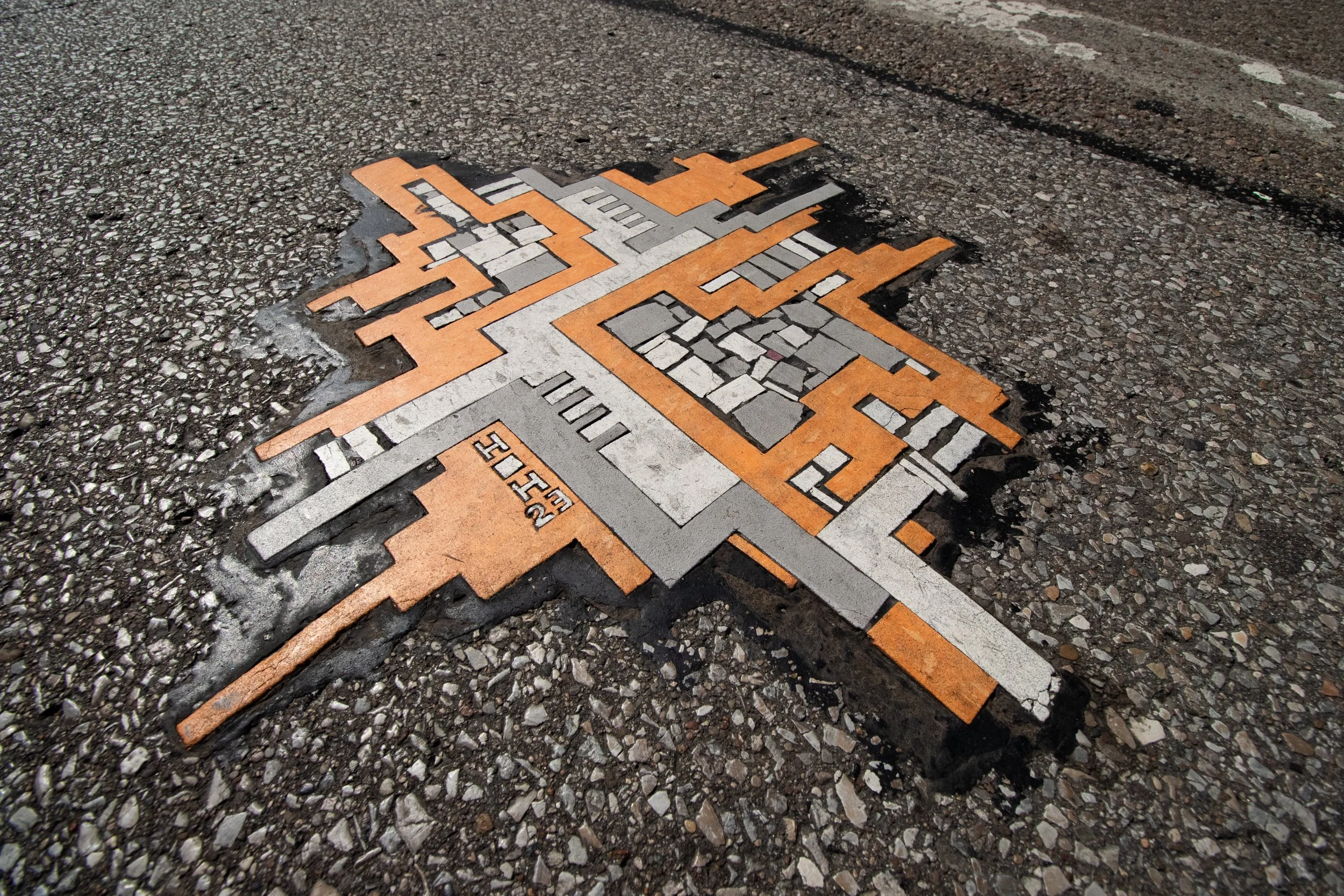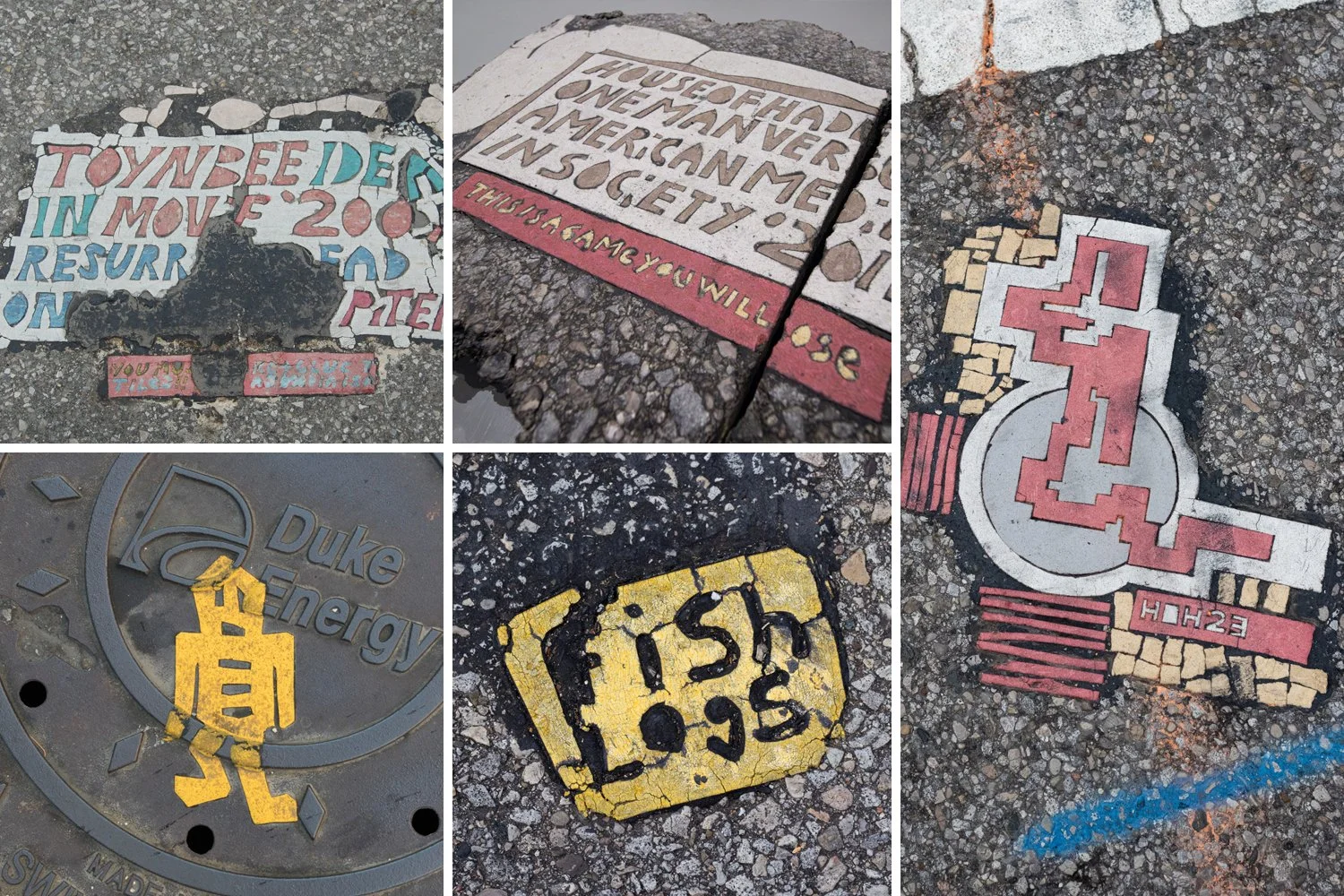2. Toynbee/House of Hades Tiles: An Update
This story is part 2 (of 5) that ultimately leads to “A Field Guide to Street Tiles and Other Literal Street Art of the Queen City.”
One of my favorite QC/D stories of all time was from last year: the one about cryptic street art found embedded within the thoroughfares of Downtown Cincinnati and many other major cities — a.k.a. the Toynbee/House of Hades Tiles. There's a mythos surrounding these things, but no firm or totally clear explanation as to their origin or meaning. There’s also a couple different ways to create them, most of which require a process that slowly reveals the tile over time. Once it finally reveals itself: it’s firmly sealed with and merged into the asphalt. One with the streets we walk, drive, and bike over.
The subject of this article seen intact in July 2017.
The tiles aren’t truly permanent, though. While they can usually withstand the seasons and the vehicles passing over them, roadwork is often the cause of their demise. Changes to the street grid and the installation of streetcar tracks in recent years finished off what was left of the Queen City’s original Toynbee examples, but a few House of Hades works could still be found. At the time of my article’s publication in August 2017 , three HOH tiles remained.
The 6th St. House of Hades tile in July 2017.
Recently, I noticed some roadwork taking place along 6th Street—the clogged, morning traffic screwing up my bike commute to work. I didn’t think much of that though, until 5chw4r7z sent me a photo: one of the tiles with construction markings on it, seemingly marked for destruction. So, I went to investigate.
A large square was spray painted across the asphalt and partially across the tile:
A few days later, cuts were made into the road and through the tile:
I was curious if the impending work would necessitate the whole tile’s removal or just a portion of the piece. Nearby, similar work was occurring that saw crews removing large sections of the road and eventually they reached the tile, so I walked down to witness its possible death, snapping a few photographs from the nearby sidewalk.
“Hey, is everything ok,” asked a member of the work crew, curious as to why I was documenting the scene.
Over the sounds of earthmoving equipment, I did my best to explain the complicated story surrounding the piece of linoleum embedded in the asphalt and featuring a peculiar and seemingly nonsensical message. The gentleman I spoke with was curious, though, and admitted that his work crew had done their best to try and preserve as much of tile as possible; now glad to hear some sort of explanation behind the thing.
“Any chance I can have the piece you’re going to cut out?” I asked.
“Sure!” he enthusiastically replied.
Like a surgeon using a massive, four wheeled, jackhammer on a mechanical arm instead of a scalpel—the man behind the controls cut into the road with precision. Soon enough I had a piece of the tile in my hand, the attached roadway still hot from the sun and the cutting tools.
Viewed in detail, you can see the strips of linoleum and a bit of how the tile is constructed. You can also see how the materials used and heat/activity of the road bonded the piece with the road surface over time.
While the work crew stated that they’d done their best to leave what remained of the tile, they weren’t sure how much asphalt sealant might cover it once their job was completed and the road repaired. A few weeks later, I noticed that the whole tile was now obscured. Presumably still there, but now laying beneath a glob a fresh asphalt or sealant. Maybe over time, I thought, the remaining tile would emerge again.
And sure enough, it did. In only a matter of a week, in fact.
The 6th St. tile as of June 12, 2018.
After a bit more rain and some time, it'll probably be even less obscured. I'm glad to see it have survived as best as possible and incredibly grateful to that work crew for their kindness. As for the chunk they let me keep—though I’d love to put it on a shelf for a cool story—it’s not mine. While I’ve never been able to get into direct contact with House of Hades, “Colossus of Roads” is the moniker for iconic folk artist buZ blurr, who collaborated on these tiles. The surviving piece is headed back to him at “Surrealville,” his workshop mentioned in several other tiles.
Maybe one day, new tiles will show up—making their presence known only once the piece has merged with the road and the artist is once again well on their way to someplace else.
Update | January 28, 2019:
The piece of asphalt made it back to buZ blurr/"Colossus of Roads" and it is now on display:
Next Chapter:
Six years after I initially investigated the mysterious “Toynbee” and “House of Hades” tiles, new ones began to emerge in Cincinnati’s streets.
All “Street Tile” Posts:
Since 2007, the content of this website (and its former life as Queen City Discovery) has been a huge labor of love.
If you’ve enjoyed stories like The Ghost Ship, abandoned amusement parks, the Cincinnati Subway, Fading Ads, or others over the years—might you consider showing some support for future projects?



















